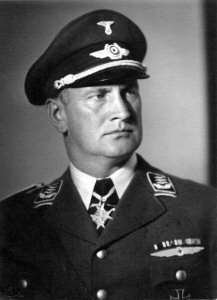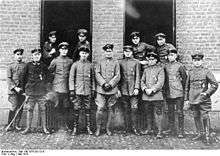Bruno Loerzer
Colonel General Bruno Loerzer (22 January 1891 – 23 August 1960) was a German air force officer during World War I and World War II. Credited with 44 aerial victories during World War I, he was one of Germany's leading flying aces, as well as commander of one of the first Imperial German Air Service Jagdeschwaders.
Bruno Loerzer | |
|---|---|
 | |
| Born | 22 January 1891 Berlin, German Empire |
| Died | 23 August 1960 (aged 69) Hamburg, West Germany |
| Allegiance | |
| Service/ | |
| Years of service |
|
| Rank | |
| Wars | |
| Awards | |
Loerzer's close friendship with Hermann Goering led to Loerzer's service in the World War II Luftwaffe, with subsequent promotion to Generaloberst by the war's end. Goering described Loerzer as "his laziest general," but swept aside criticisms of him, commenting "I need someone I can drink a bottle of red wine with in the evening."[1]
Career
World War I

Born in Berlin, Loerzer was a prewar army officer who learned to fly in 1914. Hermann Göring flew as Loerzer's observer from 28 October 1914 until late June 1915. Transferring to fighters, Loerzer flew with two Jagdstaffeln in 1916 before joining Jagdstaffel 26 in January 1917. By then he had scored two victories over French aircraft. He had his aircraft painted distinctively striped in black and white. As his victory score mounted, he was awarded the Iron Cross First Class and House Order of Hohenzollern. In November 1917, he and his squadron mate Goering each had 15 kills, and both still coveted the highest Prussian decoration - the blue enamel cross of the Pour le Mérite. Thirty years later, Loerzer would snicker to colleagues that Goering had inflated his mission claims. "Do the same," Loerzer claimed Goering had urged him, "otherwise we'll never get ahead!" [2] [3] His tally reached 20 victories at the end of October and he received the Pour le Mérite in February 1918. [4]
The same month, he took command of the newly formed Jagdgeschwader III, the third of Germany's famed "flying circuses." His aces included his brother Fritz, who claimed 11 victories. Leading Jasta 26 and three other squadrons, with Hermann Dahlmann's support as adjutant and wingman, Loerzer proved a successful wing commander. Equipped with the new BMW-engined Fokker D.VII, JG III cut a wide swath through Allied formations in the summer of 1918, and his own score mounted steadily. He achieved his last ten victories in September when he reached his final score of 44 victories. Shortly before the armistice, he was promoted to Hauptmann (captain).[4]
Between the world wars
Loerzer irregularly fought with Freikorps anti-communist paramilitary units from December 1918 until March 1920. He commanded FA 427 in the Baltic area, supporting the Eiserne Division in the tactical air role. During the 1930s he was a leader in various civil aviation organizations (National Socialist Flying Corps: NSFK), and rejoined the Luftwaffe in 1935 with the rank of Oberst (colonel). Loerzer benefited from his long friendship with Göring, becoming Inspector of Fighters with rank of major general in 1938.
World War II
During the early war years he was commander of II Air Corps, being awarded the Knight's Cross of the Iron Cross in May 1940. His II Air Corps participated in the invasion of the Soviet Union in the summer of 1941, as a section of Kesselring's 2nd Air Fleet—in support of Field Marshal von Bock. His unit was transferred to Messina, Sicily in October 1941, and he remained there until the middle of 1943, when his section returned to the Italian mainland after suffering heavy losses.
In December 1942, Fighter Ace Werner Baumbach, Group Commander of III/Kampfgeschwader 30, wrote a letter to Hans Jeschonnek, then Chief of the General Staff of the Luftwaffe, regarding the heavy losses suffered by the II Air Corps under Loerzer's leadership. Loerzer was removed from command of the II Air Corps in February 1943, and subsequently promoted by Goering to Generaloberst as Chief of the Luftwaffe Personnel Department and Chief of Personnel Armament and National Socialist Leadership of the Luftwaffe. Loerzer showed his gratitude on the occasion of the Reichsmarshall's birthday in January 1944, where he presented Goering with a carload of black market goods from Italy - women's stockings, soaps, and other rare items, complete with a price list in order to keep black market prices uniform throughout Germany. [5]
In December 1944 he was assigned to the Fuhrerreserve. He retired in April 1945, and was captured by the Americans in May 1945, and held until 1948.
Postwar
Loerzer died in Hamburg in 1960, at the age of 69.
Awards
- Iron Cross (1914)
- 2nd Class: 7 March 1915
- 1st Class: late 1917
- Knight's Cross Second Class of the Order of the Zähringer Lion with Swords: award date unknown
- Knight's Cross of the Royal House Order of Hohenzollern with Swords: late 1917
- Pour le Mérite: 12 February 1918 as Oberleutnant and leader of Jagdstaffel 26
- Iron Cross (1939)
- 2nd Class: unknown award date
- 1st Class: 14 September 1939
- Knight's Cross of the Iron Cross: 29 May 1940 as Generalleutnant and commanding general of the II. Fliegerkorps.[6][7][4]
References
Citations
- Osterkamp (1952), p. 361.
- Irving (1989), p. 366.
- In fact Goerings claims were a modest 22 [half of Loezer claims] See "Under the Guns of the German Aces"
- Franks, Bailey & Guest (1993), p. 156.
- Speer (1970), p. 322.
- Scherzer (2007), p. 512.
- Fellgiebel (2000), p. 295.
Bibliography
- Fellgiebel, Walther-Peer (2000) [1986]. Die Träger des Ritterkreuzes des Eisernen Kreuzes 1939–1945 — Die Inhaber der höchsten Auszeichnung des Zweiten Weltkrieges aller Wehrmachtteile [The Bearers of the Knight's Cross of the Iron Cross 1939–1945 — The Owners of the Highest Award of the Second World War of all Wehrmacht Branches] (in German). Friedberg, Germany: Podzun-Pallas. ISBN 978-3-7909-0284-6.
- Scherzer, Veit (2007). Die Ritterkreuzträger 1939–1945 Die Inhaber des Ritterkreuzes des Eisernen Kreuzes 1939 von Heer, Luftwaffe, Kriegsmarine, Waffen-SS, Volkssturm sowie mit Deutschland verbündeter Streitkräfte nach den Unterlagen des Bundesarchives [The Knight's Cross Bearers 1939–1945 The Holders of the Knight's Cross of the Iron Cross 1939 by Army, Air Force, Navy, Waffen-SS, Volkssturm and Allied Forces with Germany According to the Documents of the Federal Archives] (in German). Jena, Germany: Scherzers Militaer-Verlag. ISBN 978-3-938845-17-2.
- Norman Franks et al. (1993). Above the Lines: A Complete Record of the Fighter Aces of the German *Air Service, Naval Air Service, and Flanders Marine Corps 1914-1918. Grub Street, London.
- Anthony Kemp (1982, 1990 reprint). German Commanders of World War II. Osprey Pub., London.
- Theo Osterkamp, Durch Höhen und Tiefen jagt ein Herz. Heidelberg, 1952. p. 361.
- David Irving, Goering. Avon Books. New York, 1989. p.36.
- Albert Speer, Inside the Third Reich. Simon & Schuster, New York, 1970. p.322.
External links
| Military offices | ||
|---|---|---|
| Preceded by none |
Commander of Jagdgeschwader 53 Pik As March, 1937 – March, 1938 |
Succeeded by Oberstleutnant Werner Junck |
| Preceded by none |
Inspekteur der Jagdflieger 1 April 1938 – 31 January 1939 |
Succeeded by Oberst Werner Junck |
| Preceded by General Wilhelm Wimmer |
Commander of 2. Flieger-Division (1938-1939) 1 February 1939 – 11 October 1939 |
Succeeded by II. Fliegerkorps |
| Preceded by 2. Flieger-Division |
Commander of II. Fliegerkorps 11 October 1939 – 23 February 1943 |
Succeeded by Generalleutnant Martin Harlinghausen |
| Preceded by Gustav Kastner-Kirdorf |
Chief of the Luftwaffe Personnel Office 23 March 1943 – 22 December 1944 |
Succeeded by Rudolf Meister |